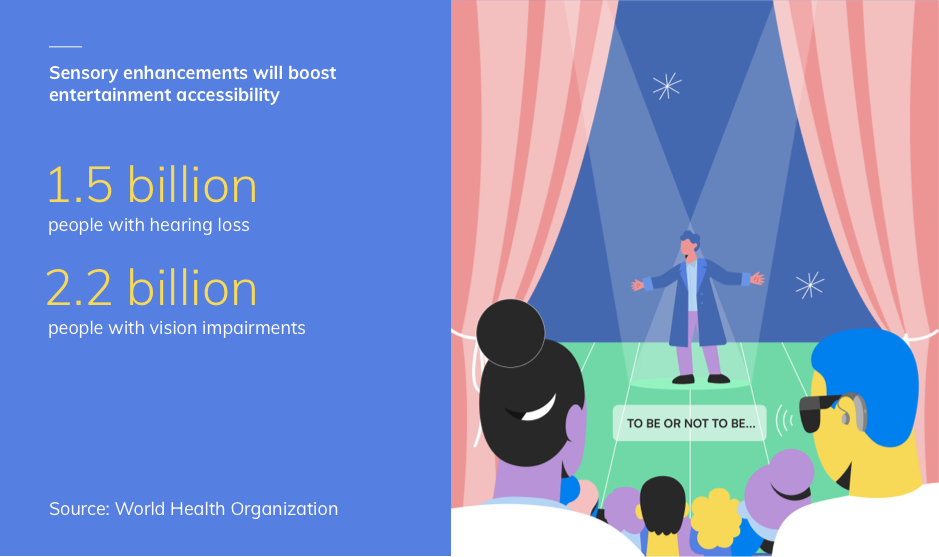The New Era of Entertainment Is Democratizing Fan Experiences
5G will allow audiences everywhere to experience the same event in real time, personalized to their preferences.
It’s said that music has the power to move you—but what if you had the power to move music?
As easy as it is to play a favorite song on the go—or even to tune into a live-streamed show—there’s something inimitable about a visceral, in-person performance. You can feel it in your bones—the bass in your chest, the thunder of applause, the spine-tingling awe as you watch the pianist’s fingers dance across the keys.
With the right amount of connectivity, that experience could be accessed from anywhere, allowing audiences to tap into the sights, sounds and sensations of a live performance wherever they are—and even share that moment with a loved one tuning in from halfway across the country.
Merging the sensory rewards of in-person spectating with remote broadcast viewing will transform the future of entertainment—and these enhancements are now within reach thanks to 5G, redefining the fan experience for everything from music shows to sport championships.
For a fan in the stands at a motorsport event, for example, the action is often out of sight; they may have a view of the start or finish line, but not both. The fan at home misses out on an electrifying immersive experience, but they do see all of the race, along with engaging statistics, expert commentators and flashback clips of their favorite drivers. With 5G-enabled technology, each fan can tap into the benefits of both viewing experiences.

More data means more power to personalize
Lower latency and increased processing power for graphics-intensive environments offer individuals the opportunity to customize their sensory experience, their perspective and even their viewing partners.
“The kind of entertainment we want is where everyone is immersed into it. Everyone feels like they’re part of what’s going on in real time. And for that we need low latency, high bandwidth, and cloud- or edge-based processing. This is the promise of 5G.”

5G isn’t simply the next generation of telecommunications infrastructure, explains Amy Wettenhall, who oversees mobility for Telstra, Australia’s largest telecom company; it allows providers to segment and slice the network, and deploy specific features and characteristics to those segments to personalize the customer and fan experience.
Imagine enhancing an at-home, virtual-reality theater experience by reading an augmented-reality program in your hands as the lights dim and the curtain rises, or amping up the bass of the score so you can feel like you’re sitting just behind the orchestra. Imagine watching the mesmerizing, synchronized movements of a ballet from a bird’s-eye view before shifting to a front-row perspective just in time for a spectacular lift of the prima ballerina.
And to heighten the experience, picture using VR to watch the performance alongside a group of friends from out of town, so you can react together as if you were taking it in, side by side, in real time.
“What we want is to build the entire pipeline that allows everyone around the globe to experience the same event at the same time and personalize the experience to their taste.”
This allows a joint personalization with others, Björn says, to the point where an individual can watch something at home with their partner or child, and each can choose how close they want to be to the action. In a highly connected world, each viewer can access the unique experience they want to enjoy.
5G will fuel all-access entertainment
As 5G reaches its full potential for sports, cultural events and entertainment at large, it will have a democratizing effect on fan experience.

Accessibility for people with disabilities is top of mind in the entertainment industry. Lower latency will, for example, quicken the delivery of audio descriptions of broadcast performances for the visually impaired, better syncing their experience to the timing that others are enjoying. Likewise, the so-called Internet of Senses—in which sight, sound and touch converge to enhance the realism of VR—will open the remote entertainment realm to people who can’t fully experience it via screens.
Sensory enhancements will also heighten in-person experiences. Telstra’s 5G Touch and Track project, for example, translates the movement of a ball on the field onto a physical device so people with vision impairments can feel a football game as it’s happening.
Crucially, 5G will enable that to happen almost instantaneously, Wettenhall says. The experience relies on translating content to data in real time; a true live match experience wouldn’t be possible with previous generations of technology.
“Harnessing 5G enables us to take the next steps on the journey of the Internet of Senses.”

That emphasis on purpose should continue leading the way as we move toward a more connected entertainment world, advises Björn, whose work at Ericsson focuses on assimilation of new technology—such as AR/VR and the metaverse—among consumers and in enterprises.
“My view is that, as researchers and as developers of products and services, it’s very important for us to look at not just what we can do with these new technologies, but what we should do,” he says.
